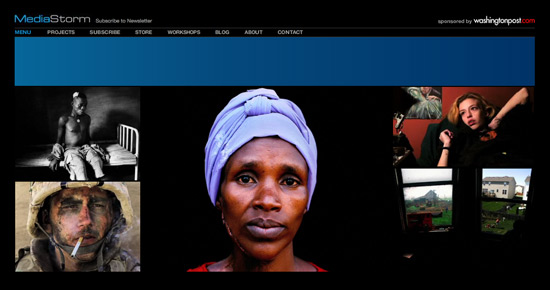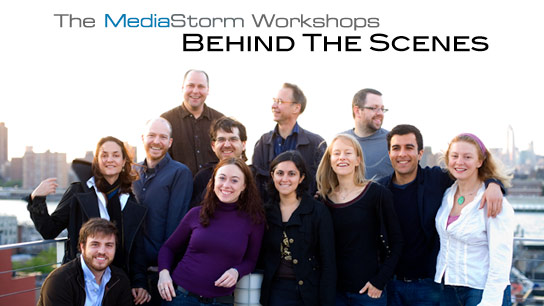MediaStorm: Story, art, passion, purpose
A few months back we asked each of our 2009 Game Changers Awards finalists to write about their projects, what they have learned along the way and what’s next. (Here’s the rest of the series). Somehow, amidst the flurry of conference preparations, this one slipped through our crack(ed) editorial process. But it’s important, so here it is, better late than never. Brian Storm  is the founder and president of MediaStorm, a pioneering multimedia production shop based in Brooklyn’s Dumbo neighborhood. Before launching the company in 2005 Brian was a multimedia producer and executive for MSNBC.com and Corbis, the photo agency owned by Bill Gates. There’s more biographical information down below. MediaStorm has elevated picture stories to an art – producing cinematic slide shows with audio narratives that set the standard for small-screen visual story-telling. The firm works with some of the world’s best photojournalists, and commercial clients ranging from Reuters to Starbucks. The company also conducts advanced multimedia training programs for teams of experienced producers. MediaStorm has been honored with numerous accolades, including two Emmy’s (2006, 2007) and three Webby Awards. Brian is an old acquaintance, we’ve chatted off and on over the years, and I’ve long admired his work. It’s intensely visual, designed and crafted with production values that are simply absent from the vast majority of text-driven web sites and blogs. Brian was at We Media Miami this year, where he took part in a story-tellers caucus that included Flyp Media’s Eduardo Danilo Ruiz, former Washington Post multimedia guru Tom Kennedy, Footnote’s Chris Willis, the UK’s David Dunkley Gyimah and others – a pretty awesome gathering of creative talent. I hope they’ll all be back next year. Here’s the MediaStorm story from Brian.
is the founder and president of MediaStorm, a pioneering multimedia production shop based in Brooklyn’s Dumbo neighborhood. Before launching the company in 2005 Brian was a multimedia producer and executive for MSNBC.com and Corbis, the photo agency owned by Bill Gates. There’s more biographical information down below. MediaStorm has elevated picture stories to an art – producing cinematic slide shows with audio narratives that set the standard for small-screen visual story-telling. The firm works with some of the world’s best photojournalists, and commercial clients ranging from Reuters to Starbucks. The company also conducts advanced multimedia training programs for teams of experienced producers. MediaStorm has been honored with numerous accolades, including two Emmy’s (2006, 2007) and three Webby Awards. Brian is an old acquaintance, we’ve chatted off and on over the years, and I’ve long admired his work. It’s intensely visual, designed and crafted with production values that are simply absent from the vast majority of text-driven web sites and blogs. Brian was at We Media Miami this year, where he took part in a story-tellers caucus that included Flyp Media’s Eduardo Danilo Ruiz, former Washington Post multimedia guru Tom Kennedy, Footnote’s Chris Willis, the UK’s David Dunkley Gyimah and others – a pretty awesome gathering of creative talent. I hope they’ll all be back next year. Here’s the MediaStorm story from Brian.
By Brian Storm, President, MediaStorm.

Your Business/Project: What is it and how does it work?
MediaStorm is an award-winning multimedia publication company with a commitment to innovative storytelling. Utilizing animation, audio, video and the power of still photography, we publish diverse narratives that speak to the heart of the human condition.
What we do is not revolutionary. Rather, it’s a response to the ever-increasing financial pressure placed on the news industry. When the bottom line is, “How much money can we make this quarter?,” one obvious consequence is that the drive to create passionate journalism becomes a secondary goal. In-depth and investigative journalism has become too expensive for most main-stream news organizations.
MediaStorm is reacting to this situation with an evolutionary response. We’re not re-inventing storytelling. We’re simply taking journalism back to a purpose-driven, rather than profit-driven approach. A steady patience and a commitment to long-form stories are the key ingredients to our work – and our success – not the pressure of daily turnarounds or the motivation of pure profit. Of course money is necessary to sustain our work, but we got into journalism not to be rich but to have a rich life and hopefully create positive change.
The MediaStorm team possesses a diverse range of talent and experience; we come from the journalism, photography and television industries, as well as design and information technology backgrounds. Our staff is actively sought by prestigious institutions and corporations to lecture and teach about multimedia storytelling as well as strategies for creating a successful business model in the digital age.
Our constant interaction with photographers, editors, educators and students throughout the world helps sustain an industry-wide discussion on the promises of multimedia. We offer a variety of online documentation to help others advance their storytelling approaches. In 2008, MediaStorm created the Advanced Multimedia Workshops, which offer an opportunity to learn in a hands-on setting with industry-leading producers adept at the changing environment of journalism.

Who are you, what’s your background and how did you wind up doing this?
I first began to realize both the power and the limitations of still photography as a storytelling medium as a graduate student at the University of Missouri School of Journalism. A photograph hanging on a wall lacks context. I want to encourage photojournalists to give their subjects a voice and not just take their picture. That’s why in 1994 at the Mizzou Multimedia Lab, I began to create interactive CD-ROMS to integrate audio with photographic essays. That was really my first foray in to multimedia. In 1995 I took a job at MSN News, which a year later became MSNBC.com. After seven years as director of multimedia responsible for the audio, video and photography I moved from Redmond, Washington to New York City to lead the editorial division for Corbis as vice president of news, assignment services at multimedia for the next two years and then started MediaStorm in March of 2005.
Today, MediaStorm is the result of two confluent trends. The first is the democratization of production tools. Everything from still and video cameras to editing software and computers has become less expensive and more powerful. The functionality of a $250,000 Avid system can now be replicated and even exceeded by Apple’s $1200 Final Cut Studio. With prices so much more affordable, more people than ever before are able to capture and publish compelling narratives.
This leads to the second trend which is distribution. Distribution has obviously been revolutionized by the Internet. Where once there were many gatekeepers that prevented work from being seen, now anyone with a web connection can easily publish their own work across the globe in a matter of minutes. In our case, MediaStorm is viewed each month by people in more than 135 countries. That kind of exposure would have been unfathomable just a few years ago.
In what ways do you feel you’ve been successful?
Success for MediaStorm is not just about producing high-quality, in-depth multimedia journalism. For us, it’s just as important that the company act as an agent of change. We want to help others realize projects of scale and importance. We want to publish with purpose. What we strive for is really advocacy journalism.

The Democratic Republic of Congo is home to the deadliest war in the world today. An estimated 5.4 million people have died since 1998. These deaths are byproducts of a collapsed healthcare system and a devastated economy. In January of 2008, MediaStorm published Marcus Bleasdale’s Rape of a Nation, a 12 minute multimedia piece that describes the horrific societal damage caused by a ten-year war in the Democratic Republic of Congo because of its vast mineral wealth including diamonds.
Five days after it was published, we received a viewer comment from a woman in Oak Glen, California, Shea Downey. She wrote, “Thank you so much for your coverage on this devastating issue.”
Watching the project raised Shea’s consciousness. The experience left her more aware of a very dire situation in a country half-way around the world. Of course, awareness raising is the goal of most traditional forms of media.
But then Shea went further, adding, “I am a small fine jewelry retail owner and intend to forward this to all I know in the industry.” Shea is a single person who can reach the right people with the right message. This surge of connectivity is what we strive for in all of our work. The ability to deliver information to that one person who can actually make a change is incredible. To have her forward that message to a larger group of jewelry store owners creates the possibility for dramatic change. It’s the ultimate MediaStorm success story.
We are always looking for ways in which to encourage people to take this kind of action. Sometimes that call to action comes from the subject of a story, telling the viewer exactly how to help. Often, it’s with text-based information such as additional links or opportunities to donate that accompany our projects on the web.
What challenges remain to be solved?
The biggest challenges facing MediaStorm are financial. The ultimate question is how do we continue to fund the long-term, time-intensive projects we want to continue making? The answer is by creating a diverse business model that includes producing for other clients and syndicating our work.
We are already one of the first, if not the first, company wholly committed to producing and syndicating multimedia projects. MediaStorm is also widely recognized for the quality editorial work we’ve produced for our many clients. We have created award-winning multimedia projects, interactive applications, and web sites for media companies, foundations and advocacy groups such as Starbucks, Council on Foreign Relations, and National Geographic Magazine. MediaStorm projects have also appeared on numerous websites including MSNBC, Slate, NPR and Reuters and have been broadcast on PBS.
The model of syndication for multimedia is not yet fully in place in our industry but I believe time is on our side. As newsrooms continue to cut staff and become even more tightly restricted by time and financial limitations, we’ll see more multimedia companies acting as agencies, syndicating content on sites that will, in turn, be paid for by advertisers.
People often think I should be more cautious about revealing too much about our company, how we envision the marketplace in five years or the free documentation we offer from our web site. But I welcome the time when there are other multimedia companies doing the kind of work we do. From my vantage point it’s far easier to change how journalism works when many others join in to help pave the way.
It takes lots of people thinking about these issues for our production model to grow. Time is on all of our sides, those working in long-form multimedia. It’s really a matter of patience.
What have you learned from your experience with this project?
One of the most important things I’ve learned in my career is that many of the long-held traditional journalistic beliefs are simply untrue. The most obvious is that young people don’t care about news and information. The fact is, as the last presidential election clearly testifies, they do want to know about the world. They want to know about Africa, the Iraq war, and all kinds of issues. They want to be informed.
Dozens of knowledgeable people also warned that in this age of micro-entertainment and bite-sized youtube videos, long-form programming for the web simply wouldn’t work. There was a belief that people didn’t have the attention span and that the web simply offered too many opportunities for easy distractions.

In Kingsley’s Crossing, a 23-year-old lifeguard from the impoverished town of Limbe, Cameroon, dreams of a better life in Europe. He embarks on a harrowing journey that takes him halfway across Africa. Photojournalist Olivier Jobard documents the passage.
What MediaStorm has witnessed is that people will, in fact, stick around to watch much longer than originally anticipated. In 2006, we produced Kingsley’s Crossing by Olivier Jobard, a twenty-one minute documentary about a young man who migrates from west Africa to France. The completion rate for that project is an extraordinary 65%. That means sixty-five percent of the people who start watching it view the story its entirety. And those numbers translate comparably across all 24 projects on our site. That’s not just good news for MediaStorm, that’s encouraging news for everyone participating in online journalism.
What are your next steps?
MediaStorm has a staff of just six. Much of our team performs three or four distinct roles. One of our designers, Tim Klimowicz, does everything from coding for mediastorm.org to designing DVD covers, building motion graphics and interactive applications. And often he does all of these things on a single day. I love the commitment and passion of our team and that our office has a kind-of-garage-band feel but I hope to add some additional expert talent in the near future. For example, I’d love to have a composer in-house who could score all of our projects. Also on my wish list are team members devoted solely to motion graphics and business development. Personally, I’d like to spend more of my time producing and less on business administration.
Long term, I hope to one day create a MediaStorm campus in upstate New York, a place for the best storytellers in the world to gather, share their insights and create important work.
In my estimation, MediaStorm has yet to arrive. We certainly don’t have it all figured out, but we are constantly working to learn more and to improve our craft. As an organization we thrive on learning. Technology we didn’t use a year ago like Twitter and Facebook are all changing how we think about our audience.
What did we do before Google? What comparable game-changing technology that we don’t yet know about is on the horizon? How will technology change the way we work in just six-months from now? As an industry, we don’t know where we are headed, so there’s a bit of mystery, but you know it’s going to be one hell of a ride.
What new questions or big ideas are you thinking about now?
We all know the famous adage, “Freedom of the press belongs to those who own one.” The fact is, we all own a printing press now and that makes the future of journalism very exciting.
I believe journalism will evolve into at least three camps. The first are those who continue to work in what can be called the mainstream, in large institutions like MSNBC, The New York Times and Reuters.
The second group has been somewhat dismissively referred to as The Crowd. The Crowd is basically anyone who has access to the tools of the craft, whether it be a blog or a still camera and a portable recording device. As we know these tools are becoming increasingly more affordable and therefore more saturated within the public. I believe more voices and a greater diversity will raise the level of public discourse and as we’ve already seen from the blogosphere, can ultimately strengthen our democracy. This makes lots of journalists frightened but it gets me excited because the competition that will inevitably result invites all of us to become better at what we do.
The third group is what I call small independent garage bands. These are groups of professional journalists who collaborate to practice their craft with quality as a focus. They are empowered by the same tools as The Crowd and can distribute globally just like the mainstream. The big difference is that they are answering to their audience, not their shareholders.
I expect all three of these groups will exist and create worthy journalism and I’m certain there will be new efforts that surprise and inspire us all as the game continues to change.
Brian Storm is president of MediaStorm, a multimedia production studio based in New York City.
MediaStorm’s principal aim is to usher in the next generation of multimedia storytelling by publishing social documentary projects incorporating photojournalism, interactivity, animation, audio and video for distribution across multiple platforms.
Prior to launching MediaStorm in 2005, Storm spent two years as vice president of News, Multimedia & Assignment Services for Corbis, a digital media agency founded and owned by Bill Gates. Storm led Corbis’ global strategy for the news, sports, entertainment and historical collections. He directed the development of Corbis’ production tools and the representation of world-class photographers for assignment work with a focus on creating in-depth multimedia products.
From 1995 to 2002 Storm was director of multimedia at MSNBC.com, a joint venture of Microsoft and NBC News, where he was responsible for the audio, photography and video elements of the site. Storm created The Week in Pictures and Picture Stories for MSNBC.com to showcase visual journalism in new media.
Storm serves on the Advisory Board for the Council on Foreign Relations, The Eddie Adams Workshop, The Alexia Foundation,The Stan Kalish Picture Editing Workshop and Brooks Institute’s Journalism School. He has judged both the University of Missouri’s Pictures of the Year and the National Press Photographers Association’s Best of Photojournalism contests.
Storm received his master’s degree in photojournalism in 1995 from the University of Missouri where he ran the School of Journalism’s New Media Lab, taught Electronic Photojournalism and produced CD-ROMs for the Pictures of the Year competition and the Missouri Photo Workshop.
He lives in New York City and can be reached via brian@mediastorm.org .



